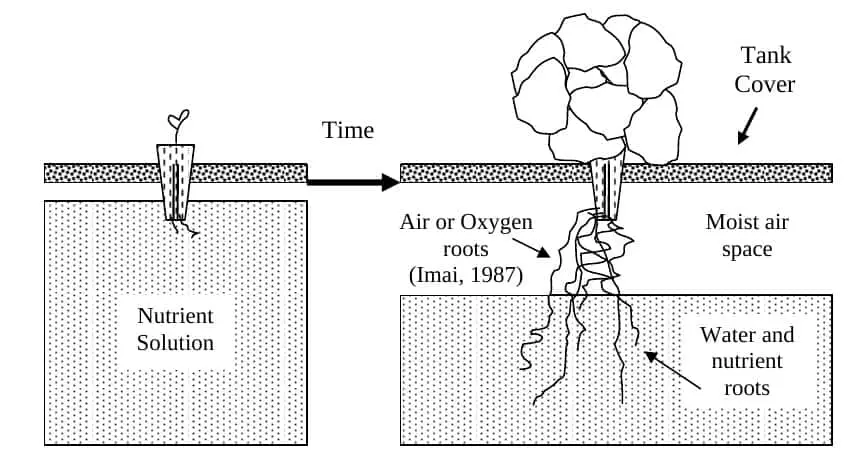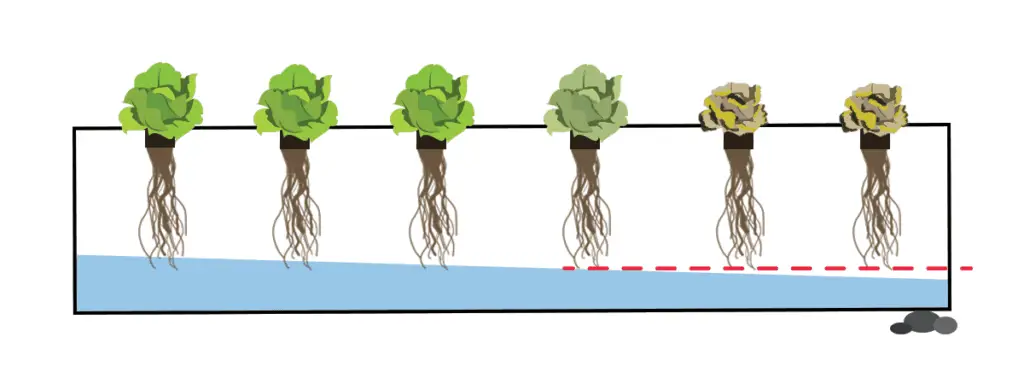Recently, I have been noticing that the noises that my air pump creates have been bothering my family members. I wondered how I could get rid of the air pump without affecting my plants. So, as usual, I researched the internet for more info, and luckily, I found out how!
So how to set up a deep water culture without an air pump? You can eliminate your air pumps by using the Kratky method. This method works by lowering the water levels of your system. The plant will develop air roots that will absorb oxygen from the surrounding air in the created air gap, and the rest of the submerged roots will be used for nutrient and water uptake.
The University of Hawaii first discovered the Kratky method in the 1990s. Since then, growers have been using it widely not only for its cost reduction by eliminating the air pump but also for its simplicity and how easily it can be set.
How The Kratky Method Works And How You Can Build One?
The Kratky method is similar to hydroponics in many different ways. There is no special nutrient required other than the ones used in hydroponics and the growing time is considered the same also.
The way these works is by placing the seedling in the net pot and leaving it to grow. The plant will use the nutrient solution and the dissolved oxygen in the water as a primary supply to grow. This will lead to decreasing solution levels in the bucket.

As a result, a gap filled with air(oxygen) will be created between the top of the reservoir lid and the surface of the solution, which will increase as the plant grows. This will lead to the exposure of the plant’s roots to the air.
The plant then will develop what is called air roots, which will be used for oxygen absorption from the surrounding air in the gap created. Moreover, the rest of the roots will keep growing downward in an attempt to reach more water. These submerged roots will be then used for the water and nutrient uptake that are essential for the plant’s growth.
Creating a hydroponic system that uses the Kratky method is super easy for newbies
10 Steps To Set Up A Kratky Method In Hydroponics
The following steps will help you set up the system in no time:
- Fill up your reservoir with distilled water
- Add normal hydroponic nutrients and follow the instructions stated on every bottle
- Check and adjust your PH (to reach 6-7)
- Add the seedling surrounded by the growing media to the net pot.
- Place the net pot in its place on the reservoir’s led.
- Have some holes made in the led for optimum airflow.
- Leave some roots above the solution level for air exposure.
- Check the solution level daily
- Refill the reservoir till it’s half when needed.
- Harvest the plant once it reaches maturity.
Top Best 7 Crops For Kratky Method
The following plants have proven great results when grown using the Kratky method:
- Lettuces (Recommended for beginners)
- Spinaches
- Cabbages
- Basils
- Mints
- Beans
- Cherry Tomatoes
The most straightforward plant to grow using this method is lettuce. You can grow it using a range of 4 – 8 liters of solution per plant and have it fully grown in about 6 to 7 weeks. Other bigger plants require larger containers and refilling the nutrient solutions several times until maturity.
However, as the container’s size becomes more extensive, the problems that you can encounter will have fewer harmful effects due to water dilution.
Important Precautions to Consider

Refilling The Nutrient Solution: If you are planning on growing relatively large plants such as cherry tomatoes, you’ll need to do some refills between the seeding and maturity. This happens due to the higher water and nutrient consumption of these plants. Make sure to refill the reservoir till it’s half with another prepared nutrient solution. Refilling the reservoir to its half only will provide the air roots with the air required for oxygen absorption and protect them from suffocation under the water. Moreover, you should flush your system with water every once in a while to avoid salt and nutrient accumulation on the floor of the reservoir.
Mosquitoes: Having water still in one place will attract mosquitoes and other undesired pests. Make sure that the opening holes in the led are slightly covered to avoid pests but at the same time allow airflow to reach the air roots.
Water Quality: You should monitor the water’s PH and salts level when setting up the system and during the growing period of the plant. I recommend you do daily checkups using an EC meter and a PH meter.
Uneven Water Levels: When setting up your container that holds the reservoir, you should make sure that water levels are equal on all sides of the bowl. Uneven water levels can often happen because the underlying ground, is not linear or on the same level. As a result, you’ll notice the weak growth of the plants present on the higher sides, especially during the late stages when the water levels are low enough to affect the plant negatively.
Advantages And Disadvantages Of Kratky Method In Hydroponics.
Advantages
One of the biggest advantages of the Kratky method is its simplicity. The Kratky method doesn’t require electricity or aeration, making it ideal for small-scale production and for those who want to save on energy costs.
Additionally, the Kratky method requires low maintenance, allowing you to spend less time on upkeep and more time enjoying your plants.
It’s also an inexpensive method to set up, requiring only a few basic supplies. You can also save up extra monthly costs by making your own hydroponic nutrients at home, the following guide is a must-read for every hydroponic grower who wants to brew their own mix of hydroponic nutrients.
Disadvantages
However, the Kratky method may not be practical for large-scale production and may not work well with all plant types.
The method is limited to certain types of plants with short growing periods, like leafy greens.
In addition, the stagnant water can lead to bacterial, algae, and fungal growth, which can be harmful to your plants. You’ll need to monitor the water levels and cleanliness of the container to prevent these issues.
When compared to DWC hydroponics, the Kratky method may not produce the same high yields due to the lack of oxygen supply.
Ultimately, the choice between the Kratky method and DWC hydroponics comes down to your goals and preferences as a grower. If you’re looking for a simple, low-maintenance method that’s ideal for small-scale production, the Kratky method may be the way to go. If you’re looking to produce high yields and are willing to put in the extra effort, DWC hydroponics may be a better fit.
Conclusion
The Kratky method for DWC hydroponics is a simple and cost-effective way to grow plants without the need for electricity or aeration. While it may not be as efficient as other hydroponic methods, it’s a great option for those who are just starting out or want to experiment with hydroponics on a small scale.
As with any growing method, there are advantages and disadvantages to using the Kratky method. It may not work well with all plants, and it requires regular monitoring to prevent bacterial and fungal growth. However, the low-maintenance and low-cost nature of the Kratky method makes it an appealing option for many growers.
I encourage you to try out the Kratky method for yourself and see if it’s the right choice for your growing needs. With a little bit of experimentation and patience, you may find that the Kratky method is a great way to grow healthy and delicious plants right in your own home. So go ahead and get started on your Kratky method DWC hydroponics adventure today!


